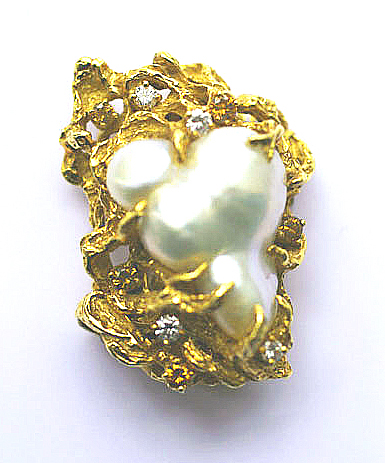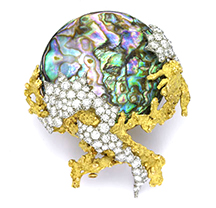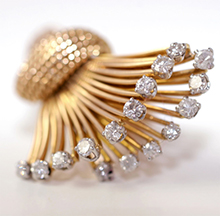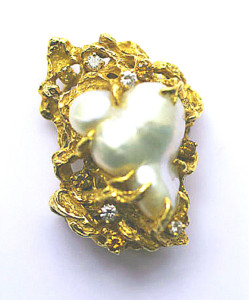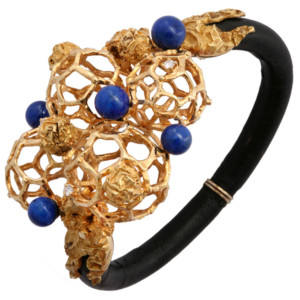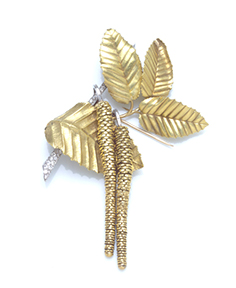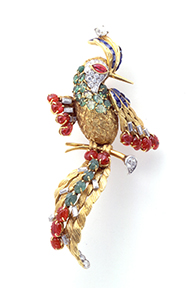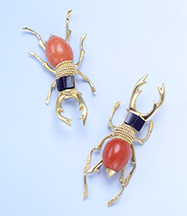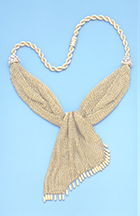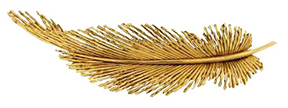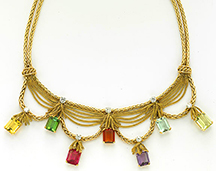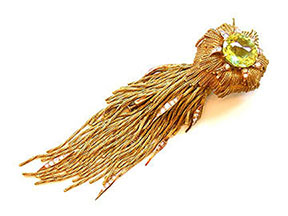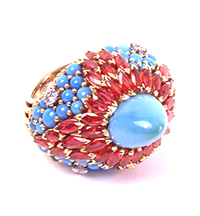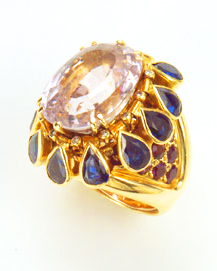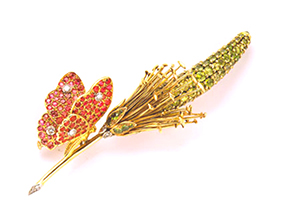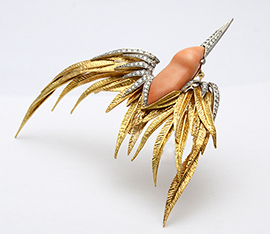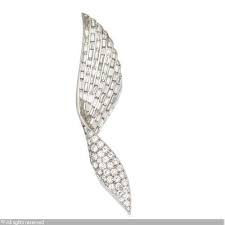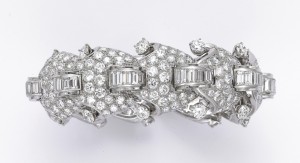After the Second World War, many wealthy and style-conscious American women regularly went to Paris for their clothes and jewels, and important American jewelry houses opened offices or showrooms in Paris, both to keep their traveling clients faithful, and to keep up with the latest styles. In the matter of jewelry design, the French have always been regarded as leaders.
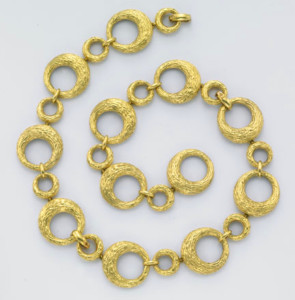
In fact, the adjective ‘French’ has, for centuries, been synonymous with the best and most luxurious in workmanship and design. Movie makers and advertising agencies have long known that just adding the adjective ‘French’ to a title or headline would make people perceive it as better, sexier, tastier, chic-er, more luxurious and extravagant. Pretty much throughout the 20th century, the French reputation for excellence in design, workmanship and that “je ne sais quoi” was richly deserved. French designers also took technical virtuosity to new heights, developing complex techniques for fashioning some of the most imaginative jewelry ever made.
Today, when you see vintage jewelry offered for sale at the most prestigious antiques fairs in New York, London and Palm Beach, the pieces are usually signed Cartier, Tiffany, Van Cleef and Arpels, Mauboussin, Boucheron, Suzanne Belperron, Sterlé, Marchak or Boivin.
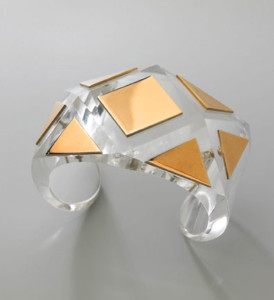
There were also a number of smaller but very important houses that produced work of exceptional quality and original design – Marchak, Mellerio, Sterlé, and Chaumet, among others – jewelry that was often the equal of the bigger and better known houses.
Top dealers and knowledgeable collectors seek out these unique pieces, made decades ago when workshops could afford to spend an extraordinary amount of time and labor fashioning an individual piece. I think too many people forget that a huge diamond rock, while beautiful, is not really a substitute for an intricately crafted, signed piece of period jewelry that possesses interesting design and timeless style.
Jewelry styles underwent a radical change as we moved into the 1950’s. The terrible war years were finally over, and both materials and skilled craftspeople were again available. It can be a bit confusing that a lot of jewelry from the early 1950’s still resembles styles from the late 1930’s. The reason is simple – jewelers put down their tools to go off to war, and when they returned, they continued where they had left off, but not for long. People wanted fresh, new styles, both in jewelry and in fashion, and major changes happened quickly.
The 1950’s and 1960’s were very creative periods for jewelry design. A number of great artists, such as Picasso, Braque and Dali designed precious jewelry. This was of great importance to jewelry design, as it contributed so many new and exciting images, shapes, textures and ideas. 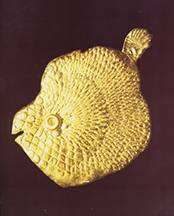
Texture was everywhere in the 1950’s – it was the new defining stylistic element.
Hardly a surface was left untouched. The sleek expanses of polished gold of the 1930’s and 40’s were gone. In their place were various kinds of textures. Various kinds of wire-work also became important elements of style. 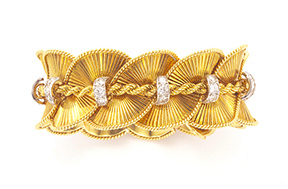
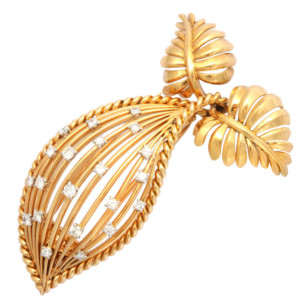
Hammered surfaces appeared, and thanks to newly developed methods of investment casting, it was now possible to create a variety of new, exciting textural elements. This technique also allowed for free-form pieces, first made in wax, and then cast in gold or silver. Stones could appear to have been pressed directly into the metal.
Arthur King, in New York City, was best known for this style, but it was also quickly adopted by Studio jewelers, who used the technique to create some very Avant-garde pieces, and Chaumet, a fine Parisian jewelry house experimented with this technique with great success. A lot of this jewelry was very new and a bit strange for many people – one either loved it or hated it.
Naturalism became a major stylistic theme, but now the creatures that had been sleek and stylized in the ‘30’s and ‘40’s were created anew, with great attention to detail. Fish regained their scales, birds their feathers. Branches were textured like bark, and flowers were exquisitely detailed.
Jewelry with animals, fish, leaves, flowers and other themes from nature was enormously popular, especially as brooches and small “scatter-pins”, which could be strewn across sweaters, jackets, and even hats.
Not only were they realistic, they were fresh and amusing.
Newly developed techniques for weaving gold so as to resemble fabric became another important design element, as did wire-work.
Wires of gold, either polished or twisted, were used to create jewelry that was both airy and architectural. VC&A used this for their Angel Hair pieces, and the great French designer Pierre Sterlé became known as ‘the torturer of gold” for the ways in which he used twisted wire in his jewels.
Various types of chain were enjoying a popularity not seen since the early 20th century. Fox-tail – a square braided chain, has existed since ancient times, and was used in Victorian jewelry, but then disappeared for a while. It was now a great favorite. It could be draped into sexy swags, and made into great tassels,
or be used with great effect to suggest feathers, fish tails or flower parts that moved with the wearer.
Pierre Sterlé and Marchak both used fox-tail to great effect.
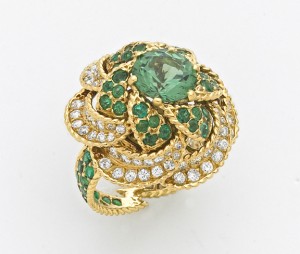
Color was now again very important. Jewelers used stones as an artist uses color, and precious and semi-precious stones were often combined for their visual effect rather than for their intrinsic value.
Enamel was also becoming increasingly important for adding bright color and subtle textures to a jewelry design.
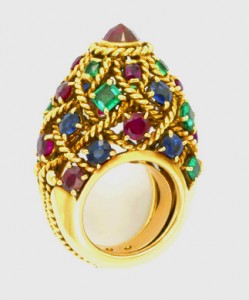
Going into the 1960’s, jewelry became bigger and even more colorful. One could wear jewelry in sizes and quantities that would have been considered vulgar a decade earlier. Geometry re-appeared, but in a modified form, as seen in the newly popular sautoirs with large tassels being made by Bulgari, Boucheron, VC&A and Boucheron. Long, heavy gold chains were also a hot new item, sometimes interspersed with stones.
Jewelers, particularly Cartier, were again taking inspiration for from India, and shapes such as paisley motifs were a popular design motif, as were the bracelets of facing animal heads last seen in the 1920’s. The Cartier bracelet of facing elephant heads, set in the Indian taste with rubies, sapphires, emeralds and diamonds is a great example.
Van Cleef & Arpels designed superb and highly original pieces, among them the amazing Zipper that could be worn as either a necklace or bracelet, and many of their iconic Ballerina brooches were introduced in the 1950’s. They also used the new woven gold in many chic and highly original pieces.
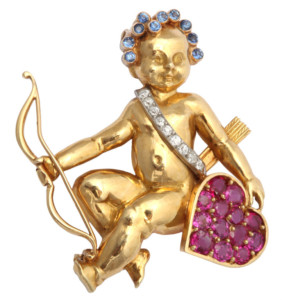
The house of Boivin’s designs were strongly reflective of what was happening in fashion and the decorative arts, but they were interpreters, not imitators. Even in the 1930’s they were producing jewels with naturalistic themes. They devised many original and innovative designs in the ‘50’s and ‘60’s, such as the “Quatre Corps” ring, designed by Baroness Caroline des Brosses, and introduced in 1950, with four tiers of diamonds.
Another ring, named “Pampilles”, demonstrates Boivin’s technical virtuosity. Tear-drop shaped stones on tiny hinges, each topped by a miniscule diamond surround a central stone, and fall open and closed like a flower.
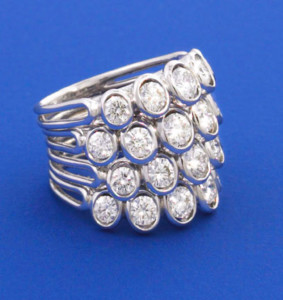
Marchak was smaller house but they produced wonderful, often humorous, and very original jewelry with superb workmanship. One charming brooch is a fruit slice. The rind is naturalistically textured, and the “flesh” is of color-graduated rubies with sapphire pits – it is so luscious that you almost expect to see juice flowing from it.
Marchak was inspired by nature, virtually capturing the essence of spring with jewels full of vitality and movement.
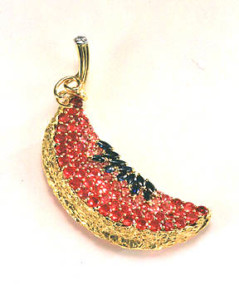
Pierre Sterlé is another name that became increasingly important in the 1950’s. He also enthusiastically embraced the new interest in Naturalism, and while he was not unique in using birds, flowers, animals, stars and other such imagery, he was very original in his interpretations. Sterlé’s jewels are often characterized by an intriguing dis-symmetry. This was a clever way of giving an even greater sense of movement to the piece. Sterlé’s jewelry is full of movement.
The pieces look as if it they are about to become airborne or are already in flight. His flowers, often with intricately carved petals seem to blow in the breeze.
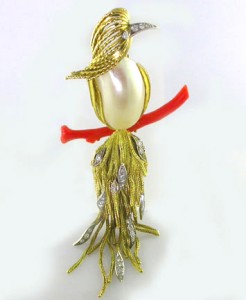
It was also now popular to create diamond jewelry using combinations of round and baguette stones.
All the jewelry houses were doing it, but Sterlé was, arguably the master, creating pieces of pure, architectural simplicity.
Hermès, well known for their coveted leather goods and silk scarves, also produced very fine jewelry. Favorite motifs were nautical inspired pieces, with bracelets and necklaces of gold woven to resemble rope. There pieces remain chic status symbols, but, alas, a lot of it now is made in Italy or Asia, and not of quite the same quality.
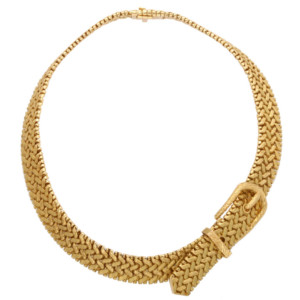
One of the reasons for the superior workmanship of French jewelry was the apprenticeship system, whereby a person would begin to learn his trade at age 14. This gave rise to a class of jeweler who were skilled in all aspects of jewelry work to a degree almost unknown today, and it is one of the things that made French jewelry so special.”
Even unsigned pieces that were relatively modest were executed with a high degree of technical skill and quality up until the 1970’s, when the older craftspeople trained in the old way were dying off or retiring. The pool of this type of highly skilled labor has thus dwindled and become much more expensive. Children no longer leave school at 12 or 14 to learn a trade.
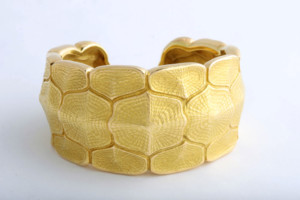
Even in France, jewelry is being made more by commercial processes and less by hand. We now hardly ever see the tours de force of workmanship that were commonplace in the past. Most jewelry houses are no longer owned by the founding families – they have become corporate, with more emphasis on that old bottom line. Jewelry designs have been simplified to require less intensive hand labor, making fine vintage pieces even more valuable and desirable.
Audrey Friedman for Primavera Gallery
The above article is copyright-protected, and may not be excerpted or reproduced without written permission from Primavera Gallery. Any borrowed images must be credited to Primavera Gallery


